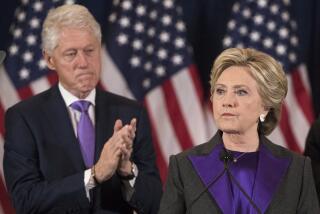BioWatch documents demanded
- Share via
WASHINGTON -- Homeland Security Department and other federal officials responsible for BioWatch, the nationwide system for detecting deadly biological attacks, have withheld key documents sought by a congressional committee, according to the panel’s leaders.
In a letter to Homeland Security Secretary Janet Napolitano, the chairmen call for her to comply with their original request for documents, which was triggered by a July 8 Los Angeles Times article that disclosed shortcomings in BioWatch’s performance.
“The response from DHS to date has been inadequate, raising serious questions about the department’s willingness to cooperate with efforts to ensure the success of the BioWatch program and transparency about its potential failures,” wrote Rep. Fred Upton (R-Mich.), chairman of the House Energy and Commerce Committee, and Rep. Cliff Stearns (R-Fla.), who heads its oversight and investigations subcommittee.
Upton and Stearns added that the Homeland Security Department “continues to withhold key documents more than three months after our initial request” and asked that those items and newly sought BioWatch materials be relinquished by Nov. 26.
The chairmen said in a separate letter to the director of the federal Centers for Disease Control and Prevention, Dr. Thomas Frieden, that the agency had provided “insufficient responses” to BioWatch-related requests that the committee sent to him in July.
The CDC assists the Homeland Security Department in coordinating with local and state health authorities that operate BioWatch.
In the event of a biological attack, the CDC would be called upon to deliver emergency medicines.
A spokeswoman for the CDC said Wednesday the agency “will continue to work toward providing the committee the information” requested.
Homeland Security representatives offered no response to the new congressional letters.
BioWatch was launched in 2003 by President George W. Bush to “protect our people and our homeland.” The Times reported in July that the system has generated scores of false alarms and, based on test results and computer modeling, could not be relied on to detect a germ attack.
The false alarms -- including the supposed detection of a deadly pathogen at the site of the 2008 Democratic National Convention in Denver -- have caused tense, protracted deliberations among government officials responsible for deciding whether to order evacuations or other emergency actions.
BioWatch operates in more than 30 major U.S. cities, where units placed atop buildings and other public places continuously suck air through composite filters. The filters are removed daily and delivered to public health laboratories, where technicians search for the DNA of anthrax, smallpox and a handful of other pathogens.
In their letter this week to Napolitano, the two congressional chairmen reiterated their interest “to determine how the BioWatch program is performing and whether it is meeting public protection goals without unduly disrupting the public health system and local emergency responders.”
The letters to the CDC and to the Homeland Security Department were transmitted late Tuesday and subsequently posted on the Energy and Commerce Committee’s website.
In their letter to the CDC’s Frieden, the chairmen described a private briefing provided by a senior agency scientist, Dr. Toby L. Merlin, who was asked by congressional staff about instances when BioWatch failed to distinguish between a pathogen that might be used in an attack and benign, “near-neighbor” organisms.
Homeland Security officials -- notably Dr. Alexander Garza, the department’s chief medical officer -- have said that BioWatch has not had a “false positive” reading, but Merlin, a pathologist who is director of the CDC’s division of preparedness and emergency infections, said that was what he would call a test result that detected a near-neighbor.
The letter to Napolitano described the Homeland Security Department’s refusal to hand over emails, meeting minutes or other internal documents that would illuminate the views of two bioterrorism experts positioned to have firsthand knowledge of how BioWatch has performed.
One of those officials, Dr. Tara O’Toole, a physician and presidential appointee who serves as undersecretary for science and technology, has overseen the department’s testing and evaluation of prototypes for Generation 3, a long-planned makeover of BioWatch that would cost taxpayers $3.1 billion in its first five years.
In their letter, the chairmen said that the Homeland Security Department had first agreed to provide the documents related to O’Toole and a subordinate, but reneged.
According to the letter, the department did so while citing “ongoing litigation between legislative and executive branches regarding congressional requests for internal, deliberative documents.”
That “is an insufficient reason for non-compliance with our requests,” the letter added.
The chairmen’s request for new responses from both the Homeland Security Department and the CDC focuses on an Oct. 23 Times article, which reported that for two years BioWatch used defective components that left the system unable to detect lethal germs.
The article reported that the components, called multiplex assays, were removed in 2009 after secret tests conducted at the CDC and the Pacific Northwest National Laboratory, in Washington state, confirmed serious deficiencies.
The committee chairmen asked Napolitano for her department’s basis for deploying those assays “and the documentation and data supporting the basis for withdrawal.”
--
More to Read
Sign up for Essential California
The most important California stories and recommendations in your inbox every morning.
You may occasionally receive promotional content from the Los Angeles Times.











